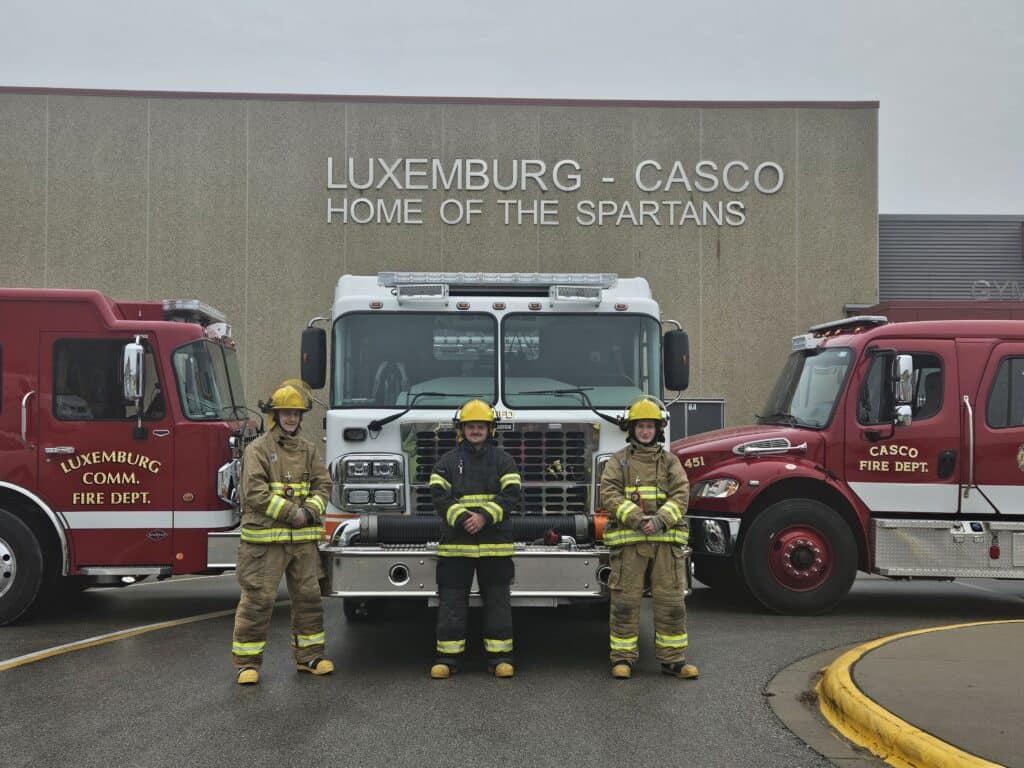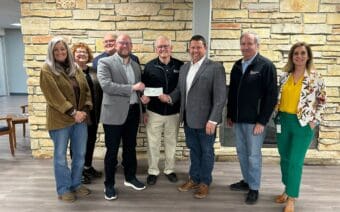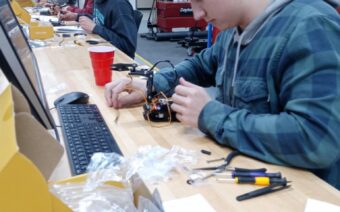
June 3, 2024
KEWAUNEE COUNTY – Figuring out what you want to be when you grow up can be a stressful and difficult task.
Recognizing this, Mike Snowberry, director of learning services for the Luxemburg-Casco School District (L-C), said the district is doing what it can to provide students with opportunities to discover what path may be right for them.
Most recently, Snowberry said, those efforts focused on the launch of the Kewaunee County Junior Firefighter Program – a new educational pathway designed for students interested in a career as a firefighter.
Three L-C students took part in the program during the 2023-24 school year, and Snowberry said more are expected to join the program in the fall.
A bit of background
The Kewaunee County Junior Firefighter Program – a partnership between the Luxemburg-Casco, Algoma, Denmark and Kewaunee school districts, along with eight area fire departments – began with an exploratory session for students in 2023.
Luxemburg Fire Chief Lew Du Chateau said he reached out to Snowberry and asked how the department could inspire younger people to become involved in the fire departments – partly because of attrition rates.
“Luxemburg and even nationwide, fire departments – especially volunteer fire departments – are becoming shorthanded with members,” he said. “Specifically with daytime help, we need help there.”
Du Chateau said the idea was originally sparked by an L-C teacher who was a firefighter – the school would let him leave if there were fire calls.
This, he said, prompted him to ask about students.
Another aspect that helped push things along, Du Chateau said, was a grant from the Wisconsin Department of Safety and Professional Services (DSPS) for PPE (personal protective equipment) equipment – which would allow the students to train and use PPE.
Snowberry said because the district has a great relationship with the fire departments, he started to reach out to other fire chiefs to get their thoughts on the idea – all of which he said gave immediate yeses.

The real hang-up, he said, became: “What can an under- the-age-of-18 volunteer firefighter do?”
To help address this, Snowberry said, the partners worked together to create a simple handbook for what that could look like – which served as the basis for how the program could start.
Program interest by students
As part of the program, students take courses at Northeast Wisconsin Technical College (NWTC) toward a Firefighter 1 certification, which are taught by NWTC instructors.
Participating students earn both high school and college credits while learning the basics of firefighting.
The three courses required to receive the certification are:
- Entry Level Firefighter, which focuses on providing the information needed to comply with fire-training requirements in Wisconsin
- Firefighter 1, which completes all Level 1 firefighter objectives as identified by the National Fire Protection Association
- Hazardous Material Operations, which prepares students to perform minimum hazardous material incident operations associated with firefighting functions
Snowberry said students who participated in the program this year had the opportunity to put on gear and participate in a mock fire rescue situation in a “burning” building.
“We gave them an experiential opportunity at the respective fire department,” he said.
The mock situation, Snowberry said, included putting on all the PPE, turning on their oxygen tanks to get the real feel and sensations, then they saran-wrapped their masks to simulate the lack of vision firefighters may have inside a burning building.
Watching the students experience this, he said, was cool.
From there, students were shown how the ladder truck works, setting all the peripherals up to get things ready.
Intense?
Yes, but Snowberry said that’s the point of the career readiness programs.
Thoughts on the program
With his grandfather and father being in the fire department, program participant Mathew Zellner said he saw this program as an opportunity to follow in their footsteps.
“Getting to leave school and go respond to the station, respond to fire calls, things like that as a high school student is amazing,” he said.
Furthermore, Zellner said the program helps kids learn more about what they want to do in the future – be that public safety, fire department or any field in which they have career training options.
Though the training is a requirement for all firefighters, Zellner said there’s a different sense of giving back as a volunteer firefighter.
“Volunteers have other primary jobs, but we still stop what we’re doing to help out the community when they’re in need,” he said. “It shows kids how to help the community differently and helps you mature into adulthood.”
Echoing this sentiment, Snowberry said the Junior Firefighter Program is a great opportunity to get the feel of what the field involves and gives organizations a chance to train and retain talent. He said it also gives students college credits at a reduced rate.
At the end of the day, Du Chateau said, it’s a win-win for everyone.
“If any of these students want to be a career firefighter, this gives them a jumpstart with their training and education,” she said. “When they get out of high school, they already have some of the training out of the way.”
And Du Chateau said it’s not just Kewaunee County areas that could benefit from this – noting if students leave the area after graduation, they’re already trained to serve in other communities.
Having finished his training, Zellner is now a junior volunteer firefighter with the Luxemburg Community Fire Department – receiving hands-on opportunities to learn the skills used in firefighting, actively participating in department trainings and meetings, and when the tone goes off, responding to calls.
“I get to respond to calls in full gear and can help out on the scene,” he said. “But, being under 18 (years old), I am restricted in what I can do.”
Junior firefighters are expected to respond to emergency calls and operate under the supervision of senior firefighters.
Strict laws exist to protect minors from the most hazardous dangers – meaning junior firefighters will never enter a burning building or operate on top of a roof.
Du Chateau said the work performed by junior firefighters frees up senior firefighters so they can execute other crucial tasks.
Some of the duties junior firefighters can perform include:
- Pull hose
- Get equipment for others
- Help with ladders, setting up ladders
- Assist on a handline
- Changing out air bottles
- Assist with setting up drop tanks and trucks
Junior firefighters, he said, must be at least 16 years old, but not older than 19 years old – and must be able to follow directions under stressful conditions.
“The Junior Firefighter Program is working well,” he said. “The students are helping out where we need them.”
Zellner said he’s taken it upon himself to share his experiences with those younger than him – participating in the Career on Wheels program, which focuses on middle-school-aged kids.

He said he’s also been doing what he can to help recruit students for the program.
“I’m hoping to build it up from here,” he said.
First year reflections
Being the first year of the program, Zellner said he wasn’t exactly sure how it would go – but said he was pleasantly surprised by it.
“Through NWTC, you get all your school paid for from your fire department,” he said. “You’re a teen doing stuff that 25-year-olds are doing at school. It’s neat as a young kid to be on the same level as the adults as you’re crawling up the ladder.”
As a junior firefighter, Zellner said he can leave school if needed for an emergency.
If he abruptly runs out of school, he said, most students know why.
Though students in the program are permitted to leave school for emergencies, Snowberry said they are still expected to keep up on homework and missed class information.
If they don’t, he said, they will no longer be allowed to leave on fire or emergency calls.
“It goes back to our philosophical belief of what responsibility is and what it means,” he said. “If you remain responsible, I will open up Pandora’s box for you.”
Zellner said his biggest advice to those wanting to join is, “just do it.”
“If you have an interest in helping out your local fire departments and communities, just do it,” he said. “It’s a great program for high schoolers.”
Du Chateau said they already have students showing interest in signing up for the fall program and she looks forward to the growth he knows will happen.
Being a change agent
Snowberry said the Junior Firefighter Program is a small fraction of a bigger solution he has been working on for five years.
As a whole, he said he believes the high schools haven’t done a great job of helping kids figure out what they want to do when they grow up – which is one reason the L-C district has placed a large focus on its youth apprenticeship and career readiness programs.
Snowberry said it sometimes starts with the question: “How do you engage someone who’s not engaged in school?”
He said L-C’s youth apprenticeship and career readiness programs help shine a light on the other opportunities outside of tech or manufacturing.
In addition to the Junior Firefighter Program, Snowberry said L-C has students working in the hospital, with the water treatment plant.
To put it simply, he said, any field struggling to find workers, the L-C school district is open to partnering with them.
To help set students up for success after graduation, Snowberry said L-C focuses on helping students “test drive careers” once they turn 16.
An example of this, he said, is the partnership the district has with Bellin College of Nursing and the University of Wisconsin-Green Bay.
“We recently had our first cohort of seven students graduate with 60 college credits,” he said. “What it’s doing is reducing the cost for parents. The school pays for the first 18 credits at $115 a credit, and the parent(s) pay after that. This is a majorly reduced rate, so parents and kids save money in the end.”
Snowberry said that’s what the district aims to do with all its students – regardless of what industry they are interested in.
The district’s youth apprenticeship program, he said, started five years ago with four students participating.
By year three, before L-C combined with the other area schools, Snowberry said the program had 300 kids participating.
Through its partnership with CESA 7 and the Greater Green Bay Chamber, that number jumped to 1,400 students.
Snowberry said this has a massive impact on both the economy and the potential to keep workers around and grow the local economy.
 BAMMYs to celebrate year two with more categories, second day
BAMMYs to celebrate year two with more categories, second day Making a difference
Making a difference








